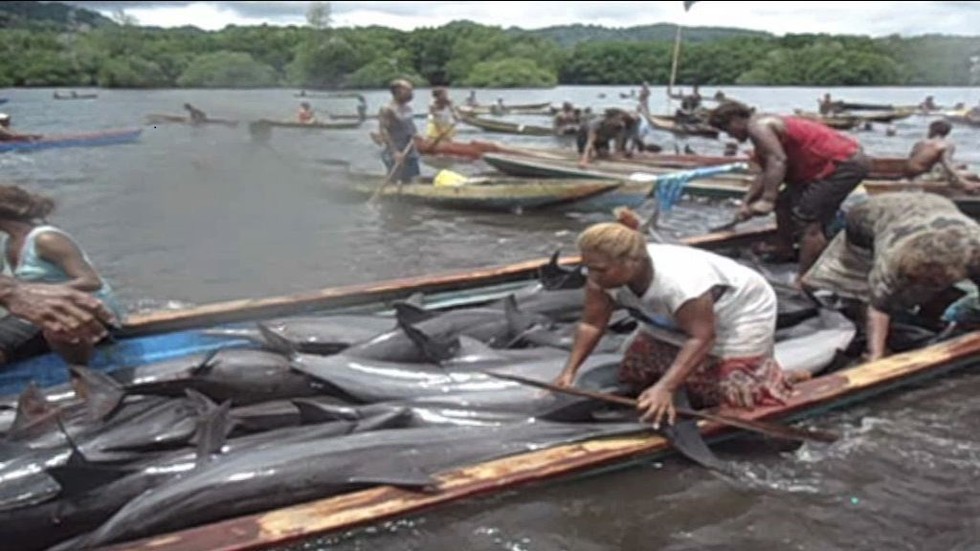Target: Colombian Minister of Foreign Affairs, María Ángela Holguín Cuellar
Goal: Illegalize the trade of fish species that are responsible for the death of dolphins.
Amazon River dolphins are hunted illegally to be used as bait for catching Piracatinga catfish, a fish that is primarily exported to Colombia where it is sold deceitfully as another species. During a hunt, dolphins are collected in nets and captured by fishermen who then tie them to submerged trees by their flukes before returning to kill them. These creatures are under threat since they are hunted and killed in a cruel manner, with the population being reported to fall at 10 percent yearly.
These animals are not only rare, but also endangered—they are the last of the five species of river dolphins that have become extinct. These dolphins have lived in the Amazon River for centuries and do not have enemies in the natural environment. Research claims that they have a brain capacity that is 40 percent larger than that of a human, and yet they are still being cruelly eliminated.
The Brazilian government recently illegalized the sale of Piracatinga catfish due to its link to the torturing of dolphins, and the ban is expected to extend for the next few years. In fact, this government has been working with its fishing industry to develop different methods of catching Piracatinga as well as creating a task force for the protection of dolphins.
Since Brazil has played its role, it is now Colombia’s turn. Colombian officials need to stop the sale of Piracatinga and enforce laws that will protect these dolphins because the Colombian consumers are indirectly promoting the killing of these river creatures without their knowledge.
Even if Colombian officials implemented these measures, they would still not be enough in stopping the illegal sale of the fish. The Colombian government has acknowledged the people’s call for action and has shown interest to help find a lasting solution. The move is a significant step in ensuring dolphins are protected, but the government of Colombia still needs to make stronger commitments to achieve real change. Sign this petition to stop the killing of Amazon River dolphins.
PETITION LETTER: Click here.
Dear Minister Holguín,
The Amazon River dolphin is under threat and is being cruelly hunted and killed. The killings are happening because the meat from the dolphin is used as bait for capturing Piracatinga catfish, which is mainly exported to Colombia and sold deceitfully.
The Brazilian government has taken an important step in ending the illegal killings of these dolphins, and it is now time for Colombia to adopt a similar stand. I understand that Colombia has shown some interest in finding a reliable solution, but I still urge your country to make a stronger commitment to protecting these dolphins. Lend your support by banning the sale of Piracatinga catfish in Colombia to help end the cruelty against the Amazon River dolphin.
Sincerely,
[Your Name Here]
Photo credit: Dennis Otten
Solomon Islanders on collision course with authorities over dolphin hunting.
The tiny Pacific nation is responding to international pressure over the slaughter of about 1,000 dolphins a year by traditional hunters and moves to end the practice are controversial and causing tensions in communities opposed to giving up their culture, source of protein and income.
Harry Styles Slams Seaworld On Opening Night Of World Tour. “The killing of dolphins must stop, it's not really what the world today needs" said tourism minister Bartholomew Parapol. Read the rest of the article below by clicking the picture: Solomon Islanders on collision course with authorities over dolphin hunting Harry Styles slammed Seaworld during opening night of the One Direction world tour on July 9, 2015 in San Diego. A concert goer captured the footage and Dr. Jeffrey Ventre of Blackfish posted it on his Youtube channel. He asked the roaring crowd: "Does anyone like dolphins" - "Don't go to Seaworld"
Harry Styles slammed Seaworld during opening night of the One Direction world tour on July 9, 2015 in San Diego. A concert goer captured the footage and Dr. Jeffrey Ventre of Blackfish posted it on his Youtube channel. He asked the roaring crowd: "Does anyone like dolphins" - "Don't go to Seaworld"
 Harry Styles slammed Seaworld during opening night of the One Direction world tour on July 9, 2015 in San Diego. A concert goer captured the footage and Dr. Jeffrey Ventre of Blackfish posted it on his Youtube channel. He asked the roaring crowd: "Does anyone like dolphins" - "Don't go to Seaworld"
Harry Styles slammed Seaworld during opening night of the One Direction world tour on July 9, 2015 in San Diego. A concert goer captured the footage and Dr. Jeffrey Ventre of Blackfish posted it on his Youtube channel. He asked the roaring crowd: "Does anyone like dolphins" - "Don't go to Seaworld"
MTV.com and other platforms has all shared this video - Harry Styles Dissed SeaWorld At A 1D Show And SeaWorld Dissed Him Right Back

Whose side are YOU on?
Will Taiji Dolphin Slaughters Save The Fox In UK?
'We Might Vote On Foxhunting As It's Like Dolphin Slaughter' says SNP MP.
SNP MPs could vote against changes to England’s foxhunting law because it is akin to “dolphin slaughtering in Japan”, a senior nationalist claimed today. Will the brutal Taiji dolphin slaughters save the foxes in the UK? Read here.
| SeaWorld Espionage Campaign Busted; Employee Caught Trying to Incite Illegal Actions |
| ||||||||||||||
Dog Saves Baby Dolphin on Criccieth Beach
'Leia' the dog saves baby Dolphin on Criccieth Beach 5th July 2015. Whilst attempting Bass fishing on a beach near Criccieth (close to the mouth of the River Dwyfor) I was taking photos of the fantastic scenery when I heard my dog barking at me from further down the beach....clearly she had found something! Managed to gently lift and guide this beached baby dolphin / juvenile harbour porpoise back out to sea. Stayed at the site for while after to make sure he didn't come back. Spoke to the coastguard once I had signal and they reported it to the science team. Think the little guy was lucky as there was nobody around for miles! And, if it wasn't for my dog barking at me I would have missed him too! Unfortunately I didn't have a mobile signal to report the sighting there and then but if you do find yourself in a similar scenario and you can call the emergency numbers here: http://www.bdmlr.org.uk/index.php or the coastguard.
You can also report sightingsh ere:http://www.seawatchfoundation.org.uk/...
Is This for Real? We Might Be Able to Communicate With Dolphins in the Near Future.
Attempting to communicate with other species on this planet has long been a far off goal of nearly every biological scientist. Aside from fantasies of becoming the real-life Dr. Dolittle, conversing with another species would offer fantastic new insights to the fields of evolution, communication, and psychology. For the most part, our attempts to teach various species to engage with us have been met with limited success.
However, new advances in science are enabling us to perhaps finally achieve this dream. Diligent study of dolphins has led many to believe that they do more than just recognize a series of clicks or hand gestures and use them to work together. Rather, the species may have what looks less like a crude form of coordination and more like a language. One that with the right tools, researchers such as Denise Herzing and her colleagues at the Wild Dolphin Projecthope to understand.
Why Dolphins?
We can easily comprehend many of the communication techniques used by lesser apes, such as community hierarchy. The structure is much the same as our own, if only a less developed version. Dolphins are altogether different though. They use sonar to “see” objects and can understand various echolocation clicks from other dolphins to identify something over 100 feet away.
Aside from humans, dolphins have some of the most well-developed brains in the world. But because of significantly divergent evolutionary paths, our brains are fundamentally different. While primates have a large prefrontal cortex (used for critical thinking), dolphins seem to have a more highly developed paralimbic systems (used for processing emotions). Both brains are capable of recalling past experiences, complex problem solving, and planning for the future.
Speaking on Their Terms
Understanding how dolphins communicate is nearly the equivalent of holding a conversation with extraterrestrial beings; our thought processing mechanisms are so varied that no conventional communication techniques will work. Luckily, with recent developments of underwater recording technologies that can process big data and make sense of it, datascientists are able to collect the millions of vocalizations dolphins make and begin to decode their meaning.
By doing so, Denise Herzing and her team hope to be able to relate to dolphins on their own terms. Much of Herzing’s current research involves encouraging dolphins to respond to few differing human-created whistles that represent a couple props. She and her team are beginning to call out dolphins by their signature whistle (much like a human name) and play dolphin games with them using the props. Thus far their efforts have been met with quite a bit of success.
Looking Ahead
Herzing and her team are collaborating with the Georgia Institute of Technology to continue to collect and analyze dolphin vocalizations in hopes of furthering their ability to interact with dolphins in a natural setting. Eventually, they hope to be able to use their technology to process what dolphins are saying, translate it to something we understand, and allow us to respond on the fly. We are still quite a ways off from that, but compared to where we were even 20 years ago we’re making leaps and bounds.
Finding a practical way to communicate with the species we share this planet with is a dream for many of us. Furthermore, documented communication with differing species provides a stronger platform for the idea that animals are emotionally aware and deserve greater legal recognition. The advent of new technology and the ability of creative individuals to put it to use is key to enabling these advances to be made. Who knows, it may be an accomplishment we see in our lifetimes.
Lead image source: Ricardo Liberato/Wikimedia Commons











